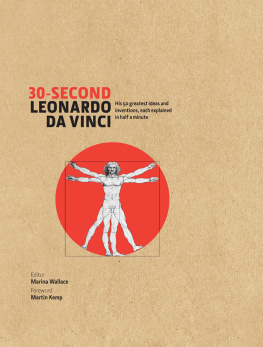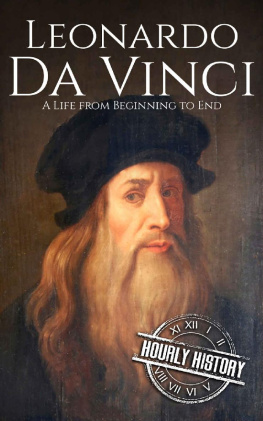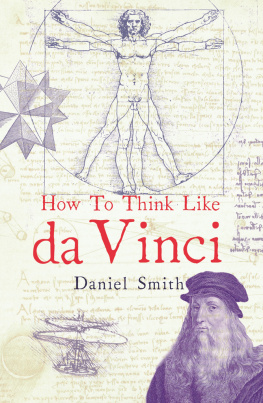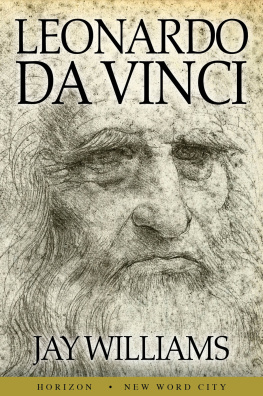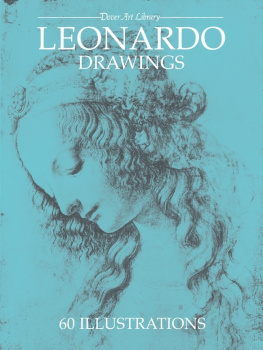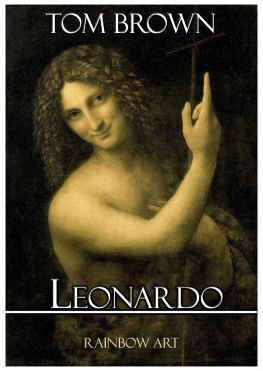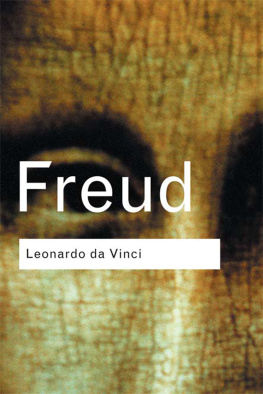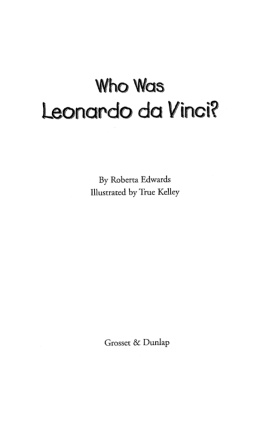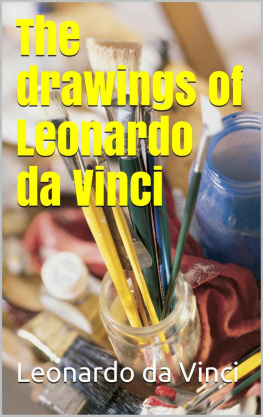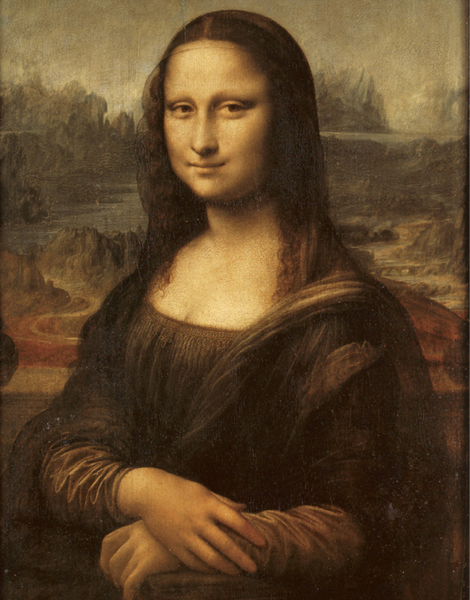
30-SECOND
LEONARDO
DA VINCI
His 50 greatest ideas and inventions, each explained in half a minute
Editor
Marina Wallace
Foreword by
Martin Kemp
Contributors
Francis Ames-Lewis
Juliana Barone
Paul Calter
Brian Clegg
Matthew Landrus
Domenico Laurenza
Marina Wallace

Artist, anatomist, architect, botanist, cartographer, engineer, mathematician, musician, scientist, sculptorthe word polymath cannot provide the full measure of Leonardo da Vincis extraordinary talents. If you only know Leonardo as the painter of the famous, much copied portrait, the Mona Lisa, seize the chance to brush up your knowledge and discover what is meant by the term Renaissance Man.
30-Second Leonardo Da Vinci is the quickest way to grapple with the truly diverse thoughts of the ultimate Renaissance superhero. Here, the worlds leading Leonardo scholars present an instant and expert guide to the breadth and brilliance of his greatest innovations. Each entry is summarized in just 30 secondsusing nothing more than two pages, 300 words and a single picture. Illustrated with inventive graphics and supported by studies of his key paintings, its the ultimate book to quench your curiosity.
CONTENTS
FOREWORD
by Martin Kemp
Leonardo roundly criticized the abbreviators those who try to take shortcuts to knowledge. This book is necessarily about abbreviation. We have, in the face of the daunting range of delightful and often exceedingly difficult material in his surviving legacy, to effect some kind of summary and synthesis. We could easily become lost in his diversity. Scholars have undertaken substantial studies of Leonardo as an artist and theorist, as an architect, as a stage designer, as an engineer, as an anatomist, a mathematician, physicist, as a geographer and geologist, and many more things. However, as Marina Wallace stresses, there is a unity at the heart of his diverse pursuits. Everywhere he sought the core of shared science that granted validity to his intellectual and practical activities. Science in this sense means a systematic body of knowledge that is verified by experience; that is to say that is drawn out of the divine order of nature.
Practical pursuits, previously regarded as crafts (including painting), were being endowed in the Renaissance with their own theories, and Leonardo was in the forefront of promoting sciences that combine abstract mathematics and the material realities of inventing things. Whatever he was doing, he was remaking nature on his own terms but always on the basis of natural law.
You are encouraged to participate in this inner unity by accessing the book in a nonlinear manner. Leonardo was the lateral thinker of lateral thinkers. When thinking about geometry, he would by association think about the motion of the water; thinking about turbulent water he would think about the curling of hair; thinking about curly hair he would think about the vortices of blood in the heart; thinking about blood in the heart he would think about vortices in mighty storms or deluges. You can make your own cross-connections. It is an exciting journey.
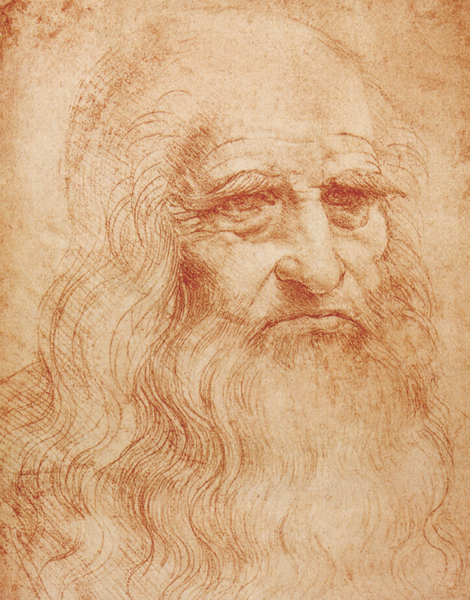
The portrait of a man in red chalk
Although this is not acknowledged as a portrait of Leonardo, it seems to sum up the main characteristics of the man and artist.
INTRODUCTION
by Marina Wallace

Leonardo da Vinci
Leonardo was born in Vinci, a small town near Florence, on April 15, 1452. His father, Ser Piero di Antonio da Vinci, was a notary, his mother, Caterina, a farmers daughter. In 1472, Leonardos name appears in the account book of the Florentine confraternity Compagnia di San Luca, and in 1476 he was in the studio of the painter and sculptor Andrea del Verrocchio (14351488).
Between 1478 and 1492, Leonardo was involved in a series of different endeavors: a commission for an altarpiece for a chapel in the Palazzo Vecchio in Florence; one for the domed crossing, or tiburio, of Milan cathedral; one for the design of an equestrian statue for Ludovico Sforza; another for an altarpiece depicting the Virgin of the Rocks for the Milanese Confraternity of the Immaculate Conception; and the stage set for a Feast of Paradise to be performed in the Castello Sforzesco in Milan.
During this period he also traveled to Lake Como in Lombardy, visiting Valtellina, Valsassina, Bellagio, and Ivrea. In 1489, he is also recorded to have inscribed one of his skull studies for his book On the Human Figure (now at the Royal Library, Windsor, UK). Such summary account of only 14 years of Leonardos life provides a sample of the variety of activities that he typically engaged with, moving from one medium to another: from painting to sculpture, to planning canals for governing the flow of water in cities, to designs for war machines to be supplied to his patrons, to inventing tools and mechanical objects, and relentlessly taking notes on what he observed in nature and all around him.
He traveled across several geographical locations, mainly between Florence and Milan, but also to Mantua, Bologna, Urbino, Cesena, Pesaro, Rimini, and Piombino. Finally he moved to France in 1516, accompanied by his pupil Francesco Melzi and his assistant Salai, where he served the French king Francis I. Throughout his life he received payments and gifts from his patrons for his work, which was often delivered late. His pension, granted by Francis I, was a highly respectable sum of money: 2,000 ecus soleil for two years. His assistants also received a good royal payment: Melzi 800 and Salai 100 ecus soleil.
On May 2, 1519, Leonardo died in the manor house of Clos Luc. The fame he had gained during his lifetime heightened after his death. His name is now known universally. One of his paintingsthe Mona Lisais the most famous in the world; anotherthe Last Supperperhaps the second most famous. The Vitruvian Man is the most famous drawing ever. The sheer quantity of his writings is daunting, the quality astonishing: the number of surviving pages amounts to roughly 6,000 and would fill perhaps 20 volumes of a modern book. His handwriting is difficult to read as it unfolds from right to left in mirror script (he was left-handed).

Renaissance Man
What is apparent in Leonardos prodigious output of paintings, drawings, and manuscripts is that he was relentless in his observation of nature, be it the human body or the movement of water in valleys and mountains. Any analysis we may carry out is always partial and needs to take into account a much wider context. We must consider that all of Leonardos investigations, his observations and records in his notebooks, have, at their base, deep and connected thoughts. Leonardo strove to ascertain principles, causes, and reasons, and to verify his conclusions through experimentation and case studies. His method relied on experience. Leonardo embodied skills and knowledge that would nowadays require dozens of different specializations, from geology to anatomy, physics, music, engineering, painting, and many more. The term Renaissance Man indicates the ability of one individual to embrace many different disciplines. Leonardo was the Renaissance Man par excellence.
Next page
